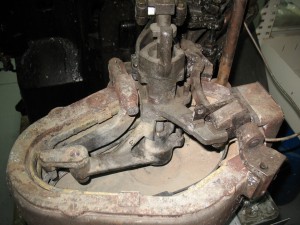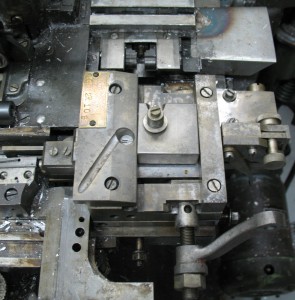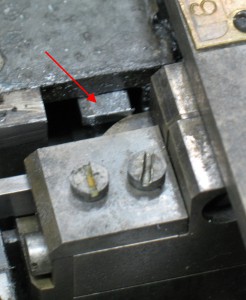One thing I would like to be able to do with my Monotype Composition Caster is to cast spacing and rule.
There is a kit of parts required to make the change-over, and I now have most of the necessary pieces:
- A Lead-and-Rule mould (mine is fitted for 3 points thickness)
- A special pump body with nozzle position altered to match the special mould
- A micrometer wedge and stand assembly which determines the exact stroke length of the mould blade
- A piece that attaches onto the centering pin arm to operate the clamp on the mould
- An automatic cutter mechanism, although mine is currently a lump of rust
Pieces that are still missing but that I can either cobble together or forego as useful but nonessential:
- Rule guide tube which keeps the rule from buckling or sagging between the mould and the cutter
- Mould blade drive linkage which reduces the type carrier lever stroke to just over ¾″ and adds a double-acting spring box
For now I just want to see the machine casting spacing so I don’t need the cutter operational, and so I don’t need the guide tube either. I think I have determined how to cobble together my own linkage as well.
While I had the caster down for a metal switchover, and the mould out as well, I decided to try fitting the pieces I have. One thing I found strange was the large number of parts which the installation steps required one to remove from the caster (from the booklet Directions for Changing from Type Casting to Lead & Rule Casting):
- Bridge
- Both Type Channel Blocks
- Type Carrier with its connecting rod and shoes
- Type Pusher and Guide
- Bridge-Lever Connecting Link (the one I forgot to hook up earlier this week)
- Piston and Pump Body
- Galley-pan Support
- Pin-jaw-tongs Spring and its links
- Locking-bar Cam Lever (disconnect only, do not remove)
Removal of most of these is indeed required to make room for the rule casting parts. I didn’t have to remove the Galley-pan Support, but if I had tried to fit the automatic cutter I likely would have. The Pin-jaw-tongs Spring and links are in the way of the linkage used by Monotype, but the home-made linkage I have in mind does not need this removed. Disconnecting the Locking-bar Cam Lever is probably to prevent the racks from wandering loosely when unlocked (which they can do when the Pin-jaw-tongs Spring is disconnected). The problem with letting them wander is that on each cycle, when the locking bars engage again, the racks will snap to one of the 15 or 17 positions making a loud snap noise and causing undue wear to the locking bar and locking teeth on the rack.
I have an English caster, so removing the Type Pusher requires removing the Rear Buffer (absent on American casters), in turn requiring removal of both sets of rear tongs.
Another side effect of the English caster is that the clamp-on extension for the centering pin arm does not fit very well. The English centering pin arm has some extra lumps of metal to accommodate the English-style low-quad mechanism and these make for a very tight fit for the extension. I find it interesting that the diagram on page 284 of The ‘Monotype Casting Machine Manual shows this extension mounted on an American-style centering pin arm even though this is a manual for the English casters.

The special lead-and-rule pump in place in the (empty) pot. Note the distinctive long space between the nozzle location and the support pin at the left end.
I did some other cleanup work on the caster and on some of the removed parts—the Type Pusher Guide was a solid mass of greasy dirt. This included cleaning out the pot, and once that was done I put the special Lead-and-Rule pump body onto its supports and tried to swing the pot closed. It wouldn’t close because, as it turns out, you can’t use an American pump on an English caster because the pump body lever sizes are different.
The the results of this experiment are that I have a few cleaned parts, some notes and measurements to make my own blade drive rod, and that in order to use this I’ll have to find a set of American pump body levers. I may have some in my parts collection.



Leave a Reply